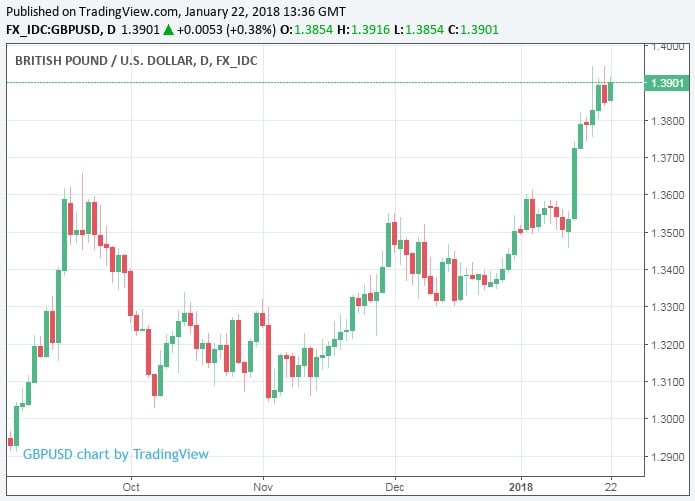A Stronger British Pound Not Yet a Threat to UK's Exporters
- Written by: James Skinner
-

Despite explosive gains for the Pound-Dollar rate, the trade-weighted Sterling remains flat and manufacturing order books should remain healthy as a result.
The rising value of Pound Sterling is not yet a threat to the post-referendum upturn in UK exports and the associated growth in manufacturing argue economists at Capital Economics, saying the British currency remains relatively cheap compared to historical levels.
Much has been made of the Pound’s rise in recent weeks; particularly after it topped the 1.39 level against the US Dollar last Thursday, marking the highest point for the Pound-to-Dollar rate since the Brexit referendum of June 2016.
However, most of this change has stemmed from a broad based weakening of the US Dollar and the Pound has held relatively steady against its other international rivals such as the Euro, Swiss Franc, New Zealand Dollar and Australian Dollar.
Above: Pound-to-Dollar rate shown at daily intervals.
Advertisement
Get up to 5% more foreign exchange by using a specialist provider to get closer to the real market rate and avoid the gaping spreads charged by your bank when providing currency. Learn more here.
“The recent rise in the Pound against the Dollar to almost $1.40, its highest level since the eve of the EU referendum, raises some concerns that a valuable source of support to economic growth – namely the boost from net trade – could soon be snuffed out,” notes Paul Hollingsworth, a senior UK economist at Capital Economics.
Typically a falling currency tends to make the cost of goods produced in a country cheaper for foreigners as the value of their own currency increases in relative terms. A rising currency has the opposite effect.
The sharp fall in the value of Sterling since the EU referendum has, as expected, seen a sharp pickup in UK exports, particularly those coming out of the manufacturing and services sectors.
The Sterling Real Effective Exchange Rate - a measurement of Sterling value based on its strength against a basket of currencies the UK trades with - has however appreciated by close to 4% since August 2017 as the Bank of England raised interest rates in November and as expectations of a Brexit deal rose.
“However, there are several reasons to remain optimistic about the prospects for net trade," says Hollingsworth, who says Sterling has not risen by enough to threaten demand for UK exports.
“The Pound has essentially moved sideways on a trade-weighted basis, with a rise in the Dollar partly offset by a fall against the Euro. We doubt that the Pound’s current strength against the Dollar will be sustained either,” Hollingsworth warns.
Above: The overall value of Sterling remains supressed by historical standards. (C) Pound Sterling Live.
There are other reasons to expect UK exports to maintain their good run.
Capital Economics also note survey measures of export orders remain robust, and point to a pick-up in export growth. Meanwhile, "the net trade boost so far has been mainly driven by services, which are less import-intensive, and less price sensitive,” says Hollingsworth.
Capital Economics say that global growth will remain robust this year which will maintain demand from foreign buyers.
While services are seen by Capital Economics to be the keystone of UK exports - unsurprising considering the sector makes up for over 80% of the UK economy - the manufacturing industry has been a relative bright spot in the UK since the referendum, with optimism among businesses in the sector rising to near five-year high during November.
Meanwhile, order books among the country’s manufacturers have risen to multi-decade high, according to the Confederation of British Industry.
Much of this upturn is the result of a weaker Pound Sterling, which has fallen by double digit numbers against its major rivals since late 2015, and more recently - a broad lift in the pace of global economic growth.
Pound Strength vs. Dollar not Justified
Sterling has risen by 3.86% against the US Dollar since the middle of December and has gained 12.29% against the US currency during the last 12 months.
Above: Pound-to-Dollar rate shown at weekly intervals.
The US Dollar index has fallen by 2% in January along which, taking its 12 month loss above the 10% threshold, has been exacerbated of late by the latest US government shutdown.
Last week American lawmakers failed to agree on a bill that will lift the US debt limit and keep the government funded beyond the weekend. As a result, the US government is now closed and federal workers have been furloughed.
This has led investors to command a greater risk premium for holding US assets, resulting in a weaker Dollar relative to most other currencies.
Hopes of a resolution to the debt ceiling standoff over the coming days are high, even if that solution is only a temporary one.
Beyond there, the Federal Reserve is widely expected to pick up the pace of its interest rate hikes in 2018, which might provide some renewed support to the US Dollar later in the year. If it does, the Pound-to-Dollar rate can probably be expected to come back down to earth.
“The Pound’s recent strength against the Dollar is not justified by either interest rate differentials, or Brexit developments, suggesting that it is more a story of broad-based dollar weakness,” says Hollingsworth.
Capital Economics forecast the Pound-to-Dollar rate will end the 2018 year at 1.3500 while the Pound-to-Euro rate will end the year at 1.1700.
This suggests the Pound could fall by close to 3% against the US Dollar but rise by a little over 3% against the Euro during the rest of the year.
Readers can learn more about what other analyst think 2018 has in store for the Pound here; Compilation of Major Bank Forecasts, Currency Views for 2018.
Advertisement
Get up to 5% more foreign exchange by using a specialist provider to get closer to the real market rate and avoid the gaping spreads charged by your bank when providing currency. Learn more here.

